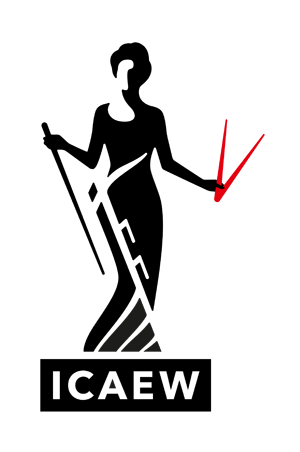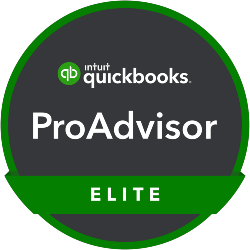1980–2016
1980-2016
An insight into the years 1980 – 2016 of Bevan & Buckland Accountants by Cuan O’Shea.
The 1980’s saw a number of developments undertaken by the firm that are still important in the 2020’s. First in 1983, the Partners decided to purchase a small block of fees in Pembroke. This became the base of the Pembroke office, and was initially managed by Charles Clewett who travelled to Pembroke a couple of days a week before permanently transferring to live in Pembrokeshire in the mid 80’s.
Secondly the Swansea office made the decision to restart training Chartered Accountants which had been in abeyance for a number of years. The firm took the first trainee in September 1985, Johnathan Evans who qualified at first attempts in every exam by 1989, he was followed in September 1986 by Alison Vickers of whom we will hear more later.
In November 1985, the firm Frank C Bevan & Co merged with another long-established firm in Swansea Sidney H Buckland & Co, and the two partners in Sidney H Buckland, John Jeremy and Wilf Jones became Partners in the newly named firm of Frank C Bevan & Buckland. The cost of ink to write this name on audit and accounting reports soon meant that the name was shortened to Bevan & Buckland. In May 1987, the firm merged with a practice in Haverfordwest. Willmott Brand who was the owner of the practice became a partner in Bevan & Buckland which now meant that the firm covered an area from Swansea to West Wales. In addition, Adrian Richards also started helping out in the Haverfordwest office, again for a couple of days a week.
In September 1985, Cuan O’Shea joined from an international firm and became a partner in Bevan & Buckland in May 1987.
In May 1987, the firm left the Swansea Docks area and moved from Albion Chambers which was near the old Evening Post building (which was next to what is now Morgan’s Hotel) to Russell House just off the traditional professional practice area of Walter Road. The move was a major investment by the partners and also enabled the firm to have plenty of space to grow in numbers and it had that very important element at that time of onsite car parking. Thus, from September 1985 to December 1987, the firm grew from 3 partners being Peter Muxworthy, Charles Clewett and Adrian Richards to 7 Partners with three offices in Swansea, Pembroke and Haverfordwest.
As we will see the acquisition/merger with other practices did change the nature of the firm from a local Swansea practice to a regional/sub regional firm with all the advantages and challenges such growth brings. One of the main changes in the Swansea office was the change in the nature of clients. Previously, prior to the merger with Sidney H Buckland the firm had a much larger bias towards agricultural clients and shipping clients. Whilst Sidney H Buckland was a smaller firm, it also had a number of larger commercial clients which began to change the nature of the firm and also had one client Swansea Housing Association as it was then called which became the base of a major specialism in the firm over the next 30 years. By 2020 the firm had 19 Housing Associations that it audited really all starting from the one firm that was initially acquired by the merger.
In addition, the firm had a number of Solicitor’s practices that were clients, and this began to also become a major specialism of the firm over the next couple of decades with the expertise of Peter Muxworthy.
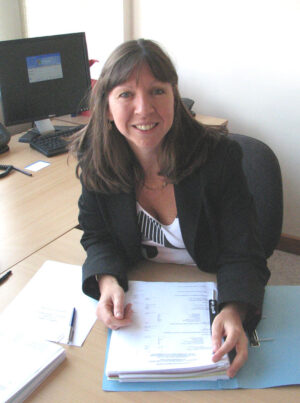
Alison Vickers, now Managing Partner in Russell House
Another development within the firm during the 80’s was the need to invest in technology. The firm in the early years of the merger between Frank C Bevan and Sidney H Buckland, benefited greatly from the knowledge of John Jeremy, one of the partners from Sidney H Buckland, who was very keen to push this side of the practice. In particular he developed a cashflow forecast programme years before the Sage programme became all powerful. The cashflow model was very robust and a major selling point with the Banks to whom we were beginning to market our services to.
Another major investment made by the firm after moving to Russell House was the decision to start a financial services department which was run by Bernard Stanton. Bernard had previously worked for an insurance company and when asked if he wanted to join us was keen to do so. Whilst the firm was regularly receiving commission for introducing clients to Insurance companies for pensions and life insurance etc, it was a major initiative to have a dedicated person inhouse to do this work.
The growth of the firm at this time meant that by 1989, the partners now had to learn more non accounting skills. This was a lesson that still applies up to the present day. In particular, marketing was something that had to be learnt. It should be remembered that Chartered Accountants were not actually allowed to advertise their wares in newspapers etc up until the early 1980’s (the internet did not exist at this time).
The way to market yourself was to join in clubs and societies e.g. Rotary, Round Table, Rugby/Football Clubs etc. The concept of approaching potential clients directly was viewed by some with some suspicion and by some it was seen as unethical. This view has not totally disappeared up to the present day.
However, by the late 1980’s the firm was beginning to adopt various marketing strategies such as:
1, entertaining bank managers and solicitors regularly
2, developing specialisms especially in the legal profession and financial services
3, essentially trying to tell potential customers what we can do.
To do this the partners in particular needed to be trained in how to give presentations and generally how to develop new business. Courses run by the Institute of Chartered Accountants were in fact very useful for Partners at this time and probably still have a benefit to this day. They were very influential in ensuring that the firm developed a greater marketing focus throughout the firm.
The changes in partnership continued throughout the 1990’s. Willmott Brand, the partner in Haverfordwest retired in 1991 and he was replaced by Stuart Warner, an Oxford graduate, who then ran the Haverfordwest office until 2001. Stuart’s appointment as Partner meant that Adrian Richards could then come back to Swansea to further develop work within the Swansea office. Again in 1990 there was a further major boost to the firm when the firm in Swansea acquired a small block of fees from a local practitioner Barry Page. Although the value of fees was quite small, there were a sizeable number of local Charities. This batch of Charities was an introduction to the Not for Profit sector and along with a big investment in training and marketing has now enabled the firm by the 2020’s to be one of the major Charity sector accountants in South Wales, with clients throughout South Wales area and even into the West of England. We now act for over 75 Not for Profit clients.
So, from being a local Swansea firm in the start of 1985 by the mid 1990’s the firm was operating throughout the M4 corridor from Newport Gwent to Newport Pembrokeshire.
One area of expertise where the firm did not have a presence was insolvency. This was remedied when Alun Evans, an Insolvency Practitioner, joined the firm in November 1992 and became a partner in the Haverfordwest office on the 1st August 1995. Alun had started in the Pembroke office and then ultimately transferred to work alongside Stuart Warner in Haverfordwest.
One other area of work that we felt that we could improve on was more specialised tax work and again to this effect we recruited Huw Evans as a tax partner on 1st January 1994. Huw joined from an international accounting practice having previously worked in Cardiff and Swansea. However, more importantly he had first been an Inspector of Taxes and was the first partner in the firm not to have been a qualified Chartered Accountant. Again, this was a sign of widening horizons within the firm.
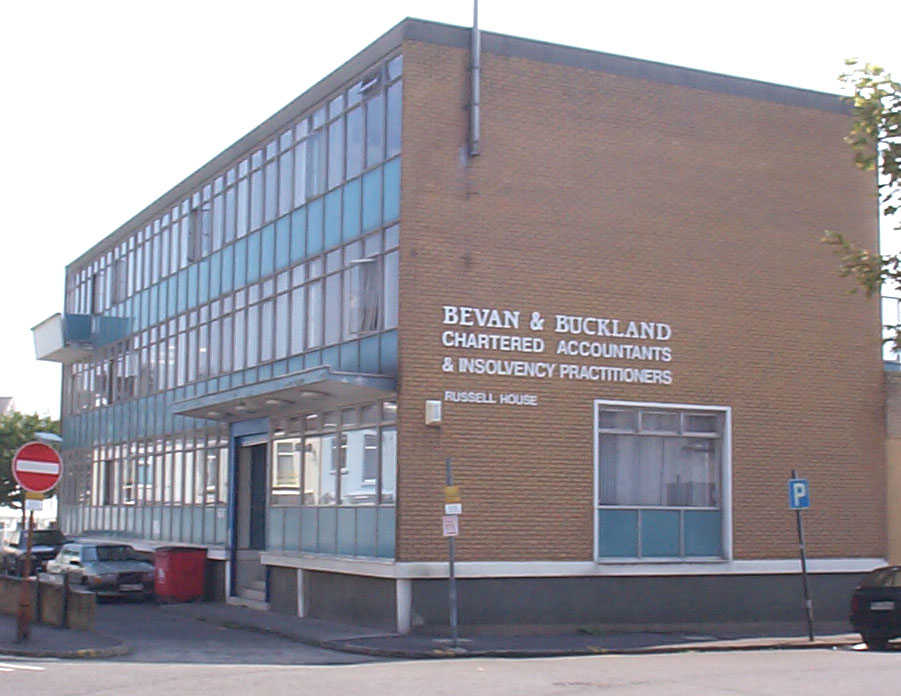
The Russell House office on Russell Street in Swansea has since been demolished
The continuing growth of fees meant that there was a need to appoint a further audit/accounting partner in Swansea and on the 1st May 1997, Alison Vickers who had joined us as a trainee accountant 11 years earlier, became a partner. Again, the mix of having home grown partners and people who joined from other firms, was beginning to be recognised as a strength of the firm in its mission. Alison from day one has brought in a significant amount of work into the firm and had enabled us to increase the profile of the firm in a number of areas, in particular, charities, solicitors and general commercial clients. After the recession of the early 1990’s there was a period of continuing good growth for the firm. Again, building on the decisions made in the 1980’s, the head count increased every year which really showed the wisdom of moving to much larger premises at Russell House.
One major initiative that took place in the late 1990’s was the project to put a computer on every person’s desk in the firm including the Partners. This was probably a bigger step than the invention of the biro pen (see earlier in the firm history). The project was led by John Jeremy, helped by Huw Evans and our newly appointed IT manager, Ian Thomas. This was another example of the firm being prepared to invest for the future.
The next big undertaking for the firm was to manage the retirement of the original Partners of Frank C Bevan & Sidney H Buckland i.e Peter Muxworthy, Charles Clewett, Adrian Richards and John Jeremy.
Adrian Richards retired in 1995 to develop a long-standing interest in a Caravan business. John Jeremy retired in 2000. Charles Clewett who had moved to Pembrokeshire in the late 1980s, undertook a major growth project in Pembrokeshire which saw the firm acquire new premises at Castle Chambers in 1991. The firm in Pembroke grew significantly during the 1990’s. Charles decided to retire in 2001.
Finally, Peter Muxworthy who had been Managing Partner with the firm for the period 1975 to 1995 retired as a Partner in 2001. He continues as Consultant.
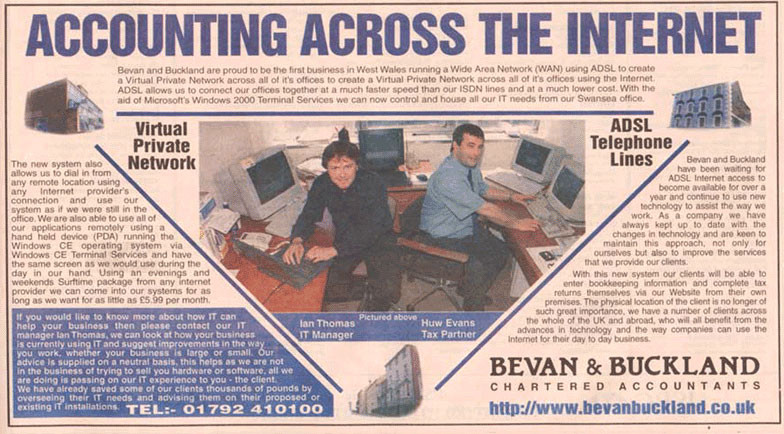
An article from the Evening Post as Bevan & Buckland were the first firm in West Wales to connect their offices with an ADSL VPN.
With Charles Clewett’s retirement from the Pembroke office of Bevan & Buckland 2001 there was a need to replace him in that office. He was succeeded by Caroline Wheeler, who was another person who had joined us as a trainee accountant in the Haverfordwest office. Caroline’s back story is interesting in the sense that she joined the Haverfordwest office as a mother of 4 children and started as an accounting technician trainee. She was successful in passing these exams and then encouraged by Stuart Warner went on to successfully qualify as a chartered accountant. Finally, she became a Partner in the firm on 1st December 2001. Her success in the firm enabled her to win the Returner of the Year award at the Welsh Woman of the Year Awards in 1998. Stuart Warner who had been a partner in Haverfordwest left the firm in 2001 to develop a consultancy practice and Huw Evans also left the firm in 2004 to take part in a Swedish Property Investment Scheme.
The retirement of Huw Evans meant that we needed to recruit a new Tax Partner. Huw was replaced by Jeanette McLellan who joined us from the International firm PWC in Swansea. Jeanette brought a good mix of taxation and accounts experience to the firm and at the time Jeanette joined us we were probably one of the few firms in the UK where we had a 50/50 split of female and male partners. For the size of firm this was pretty much unheard of in South Wales.
The first decade of the 21st Century, saw the continuing growth in the firm which certainly meant an increase in numbers of staff which as mentioned earlier, does bring its own challenges. Also by the end of the decade we were beginning to outgrow the office at Russell House. In particular, car parking which had been its great advantage was now becoming a problem. Our search for new offices took a number of years, partly because of the fact that very few people were building offices in Swansea but also because in 2008 the financial crash did mean that development and finance became difficult. However, in September 2009 the firm acquired new premises at Langdon House and moved into the offices in late March 2010. At the same time on the 1st May 2010, Harri Lloyd Davies became a Partner in the firm. Harri was another partner who had qualified with us and was now successful in becoming a partner.
Harri was under 30 years of age when he became a partner and so brought new ideas and new ways of working to the firm. In 2013 we saw the retirement of Bernard Stanton from the Financial Services side of the firm. Also, in 2013, Paul Arnold joined the firm as a Tax Partner. Paul had previously worked for a couple of International firms and when he joined us, he specialised in Research and Development claims. Again, this proved to be a very successful investment by the firm. In April 2013, Jeanette McLellan decided to retire from the firm and in late 2016, Cuan O’Shea retired as Managing Partner. Alison Vickers who started as a trainee in 1986, became the Managing Partner in 2016 and her first appointment was to recruit Matthew Denney as a Tax Partner, specialising in Trusts.
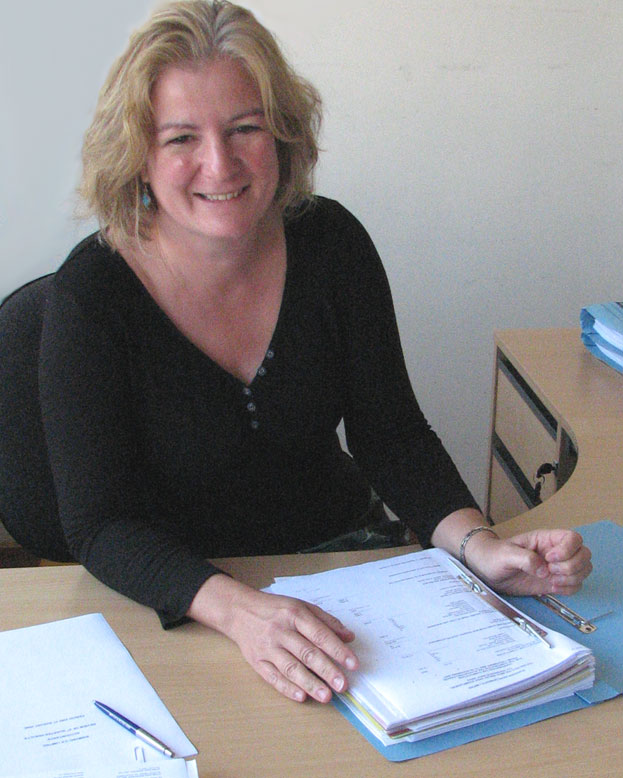
Jeanette McLlelan – Former Tax Partner
So, when we look at the growth of the firm since 1984, there is a trend which can be summed up in the following terms.
1, Training, the company has continued to train on both the technical side but perhaps more importantly on the non-technical side such as marketing and HR issues, this certainly continues to the present day.
2, the importance of technology cannot be underestimated and is now an integral part of being an accountant today. We have travelled from the biro pen through fax machines to Zoom.
3, being prepared to make big investments.
4, making the right decisions on big issues.
The firm has been successful because of the success in getting the four things mentioned above correct and hopefully this will continue for the future.




